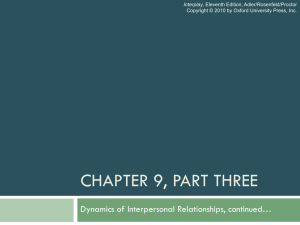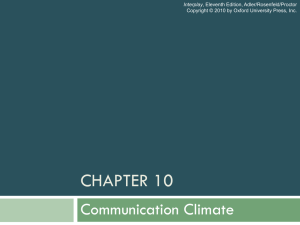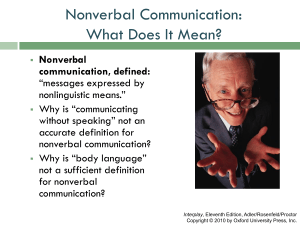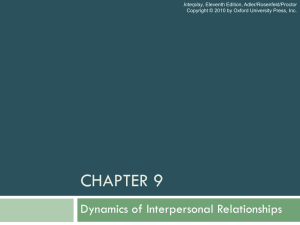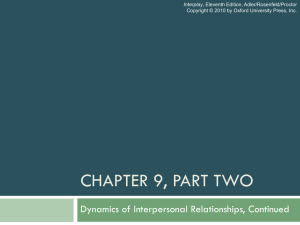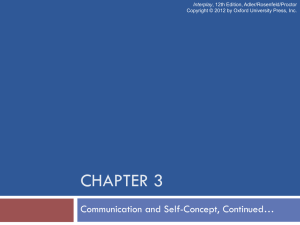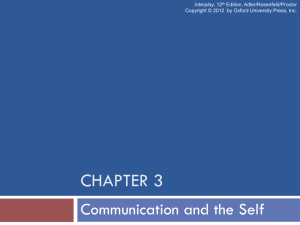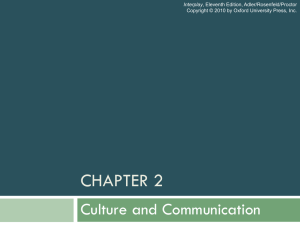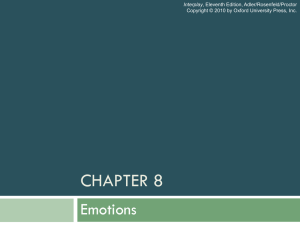Ch03b_Interplay11 - Forensicconsultation.org
advertisement
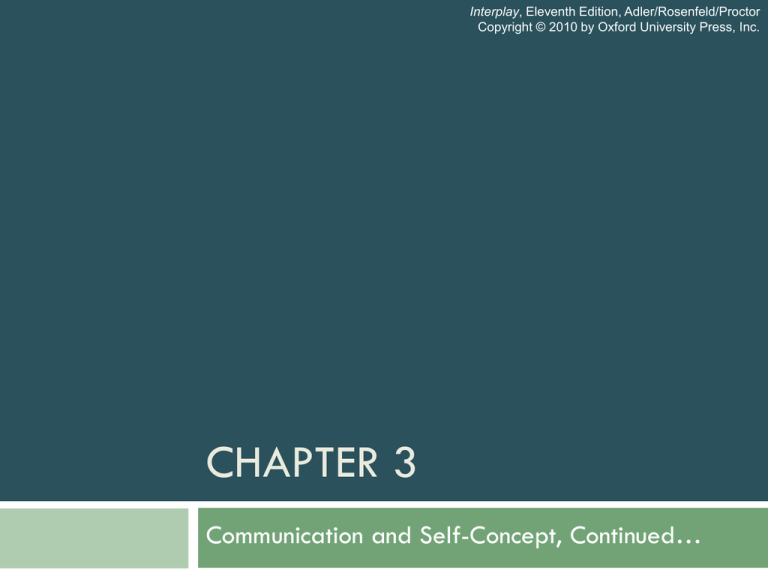
Interplay, Eleventh Edition, Adler/Rosenfeld/Proctor Copyright © 2010 by Oxford University Press, Inc. CHAPTER 3 Communication and Self-Concept, Continued… Interplay Section 6 DISCLOSING THE SELF: CHOOSING WHAT TO REVEAL Interplay, Eleventh Edition, Adler/Rosenfeld/Proctor Copyright © 2010 by Oxford University Press, Inc. Choosing What to Reveal Self-disclosure Every verbal or nonverbal behavior we engage in is self-revealing Distinguishing factors of self-disclosure: Honesty Depth Availability of information Context of sharing Interplay, Eleventh Edition, Adler/Rosenfeld/Proctor Copyright © 2010 by Oxford University Press, Inc. Models of Self-Disclosure Degrees of Self-Disclosure: The Social Penetration Model (Altman and Taylor) Two dimensions: Breadth of information volunteered Depth of information volunteered Altman and Taylor: “the development of a relationship as a progression from the periphery… to its center. Process occurs over time.” Types of information revealed: Clichés—ritualized, stock responses to social situations Facts Opinions Feelings Interplay, Eleventh Edition, Adler/Rosenfeld/Proctor Copyright © 2010 by Oxford University Press, Inc. Awareness of Self-Disclosure: The Johari Window Model Johari Window (Luft and Ingham) Frame contains likes, dislikes, goals, secrets, needs. Part 1: Open area; information of which both you and the other person are aware. Part 2: Blind area; information of which you are unaware, but the other person knows. Part 3: Hidden area; information that you know, but aren’t willing to reveal to others. Part 4: Unknown area: information unknown to you and others. Interplay, Eleventh Edition, Adler/Rosenfeld/Proctor Copyright © 2010 by Oxford University Press, Inc. Interplay Section 7 BENEFITS AND RISKS OF SELF-DISCLOSURE Interplay, Eleventh Edition, Adler/Rosenfeld/Proctor Copyright © 2010 by Oxford University Press, Inc. Benefits of Self-Disclosure Catharsis Self-clarification Self-validation Reciprocity Impression formation Relationship maintenance and enhancement Moral obligation Social influence Self-defense Interplay, Eleventh Edition, Adler/Rosenfeld/Proctor Copyright © 2010 by Oxford University Press, Inc. Risks of Self-Disclosure Rejection Negative impression Decrease in relational satisfaction Loss of influence Loss of control Hurt the other person Interplay, Eleventh Edition, Adler/Rosenfeld/Proctor Copyright © 2010 by Oxford University Press, Inc. Alternatives to Self-Disclosure Silence Lying Equivocation Benevolent lies, unmalicious Told for the benefit of the recipient Equivocal language: Two or more plausible meanings Used for face-saving Can save a speaker from being caught lying Hinting Face-saving Interplay, Eleventh Edition, Adler/Rosenfeld/Proctor Copyright © 2010 by Oxford University Press, Inc. The Ethics of Evasion Provides a way to manage difficult situations There are times when honesty is the right approach, even when painful Consider: Are the effects of a lie worth the deception? Is the indirect message in the interest of the receiver? Is evasion the only way to behave? How would others respond if they knew what you were really thinking/feeling? Interplay, Eleventh Edition, Adler/Rosenfeld/Proctor Copyright © 2010 by Oxford University Press, Inc. Guidelines for Self Disclosure Is the other person important to you? Is the risk of disclosing reasonable? Is the self-disclosure appropriate? Is the disclosure relevant to the situation at hand? Is the disclosure reciprocated? Will the effect be constructive? Interplay, Eleventh Edition, Adler/Rosenfeld/Proctor Copyright © 2010 by Oxford University Press, Inc. Interplay END OF SECTION Interplay, Eleventh Edition, Adler/Rosenfeld/Proctor Copyright © 2010 by Oxford University Press, Inc.
